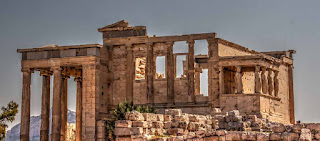Climbing to the Acropolis
Our last stop on this trip was also the end of our cruise. The last stop was Athens, Greece, and we
decided to stay an extra day to see the Acropolis. For a bit of history, Athens dominates the
Attica region and is one of the world's oldest cities, with its recorded
history spanning over 3,400 years and its earliest human presence beginning
somewhere between the 11th and 7th millennia BC. In the 6th century BC, the Acropolis
was the most important sanctuary of the city and was primarily dedicated to the
goddess Athena. Although we didn’t get
to see all the structures at the top of the hill known as the Acropolis, we did
get to see what I consider the major ones.
This image of the Parthenon was seen from our traveling companions’ hotel room and served as a beacon, calling us to explore! The Parthenon was a temple dedicated to the goddess Athena. Interestingly, in the final decade of the 6th century AD, the Parthenon was converted into a Christian church dedicated to the Virgin Mary. But let’s first climb to the top of the Acropolis to see it closer!
When we got to the bottom of the hill (remarkably close to the hotel), the first thing we saw was a cistern (upper left image) that once held drinking water for those who lived close by. The outside of the Odean of Auditorium (upper right image) was not too far from the cistern. This auditorium measured 43,000 square feet and was built at the southeastern foot of the Acropolis. It was first built in 435 BC for the musical contests held there. The image on the lower right was of a statue in a niche outside the auditorium. (The white gate is there for security purposes.) The last image, on the lower left, was taken after we walked around and began the climb to the top. Y0u can see the backside of the structure that is the front of the entrance, and if you look closely, you can see light shining through the actual open entrances.
As we continued our climb, off to the right, we saw this monument, standing tall in the city of Athens. It is the Philopappou Monument. Philopappos died in 116, and his sister, citizens of Athens and possibly even the imperial family were full of grief. To honor his memory, a tomb structure was built on a hill formerly known as Muses Hill. The hill is now known as Philopappou Hill.
It was quite the climb to the top of the Acropolis, and we sometimes walked closely by buildings like this one. Unfortunately, we had no idea of what this building was. I was quite surprised we could get this close to any structure!
This structure is known as The Proplylaia and is the monumental ceremonial gateway to the Acropolis. It was built between 437 and 432 BC and was the last in a series of gatehouses built. In the lower portion of the image, you can see the tops of some people’s heads. It was quite crowded at the time we made the climb.
This is the Parthenon as it stands today. It was a temple dedicated to the goddess Athena, who was considered the patroness of Athens. Construction began in 447 BC and was completed in 438 BC, although decoration continued until 432 BC. In September 1687, a bombardment explosion left the Parthenon in ruins. Although it was restored between 1900 – 1933, some of the building materials used seriously damaged the ancient marble and created structural issues. Since 1975, numerous restoration projects have been undertaken to protect the structural stability of the temple. In the image above, you can see a couple hundred of our closest friends who toured the Acropolis with us – just kidding!!
In this image of the Erechthem, I did manage to “cut out” all the fellow visitors! The Erechthem is the iconic temple of Athena, built during 421 – 405 BC. It is famous for the degree of complexity and perfection of details. This is a lovely overall view of it in its current state of glory, in a way.
Here are a few different views of the Erechthem. This was my favorite structure on the Acropolis, mainly due to the detail of the inside of the temple (see images on right and left) and the women statues holding up part of the structure. These women are called caryatids – draped, sculpted female figures. History of caryatids tell us that young girls would visit the sanctuary, carrying upon their heads fruit and walnuts. These are the most famous caryatids of Greece.
Since the statues and structures in the Acropolis didn’t allow people to get close to them or lean on them (in order to preserve them), Jeff didn’t get to do his traditional "lean on history" routine. But, as we exited the area around the Acropolis, there were some rocks that are presumably fairly old, so Jeff got to do a vacation tradition after all!
As we were no longer cruising, I couldn’t end this post, and the series of posts covering our wonderful cruise, with a scenic moonrise or sunset. Instead, I am leaving you with this close up of the caryatids of Erechthem– my favorite structure on the Acropolis! Until next time!!
Enjoy!




























